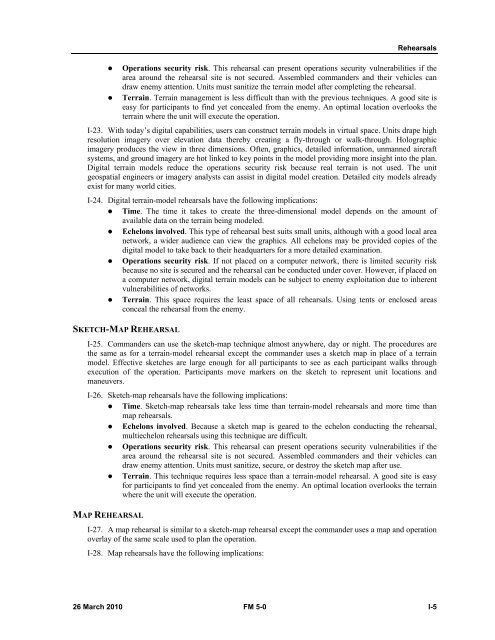FM 5-0, The Operations Process - Federation of American Scientists
FM 5-0, The Operations Process - Federation of American Scientists
FM 5-0, The Operations Process - Federation of American Scientists
You also want an ePaper? Increase the reach of your titles
YUMPU automatically turns print PDFs into web optimized ePapers that Google loves.
Rehearsals<br />
• <strong>Operations</strong> security risk. This rehearsal can present operations security vulnerabilities if the<br />
area around the rehearsal site is not secured. Assembled commanders and their vehicles can<br />
draw enemy attention. Units must sanitize the terrain model after completing the rehearsal.<br />
• Terrain. Terrain management is less difficult than with the previous techniques. A good site is<br />
easy for participants to find yet concealed from the enemy. An optimal location overlooks the<br />
terrain where the unit will execute the operation.<br />
I-23. With today’s digital capabilities, users can construct terrain models in virtual space. Units drape high<br />
resolution imagery over elevation data thereby creating a fly-through or walk-through. Holographic<br />
imagery produces the view in three dimensions. Often, graphics, detailed information, unmanned aircraft<br />
systems, and ground imagery are hot linked to key points in the model providing more insight into the plan.<br />
Digital terrain models reduce the operations security risk because real terrain is not used. <strong>The</strong> unit<br />
geospatial engineers or imagery analysts can assist in digital model creation. Detailed city models already<br />
exist for many world cities.<br />
I-24. Digital terrain-model rehearsals have the following implications:<br />
• Time. <strong>The</strong> time it takes to create the three-dimensional model depends on the amount <strong>of</strong><br />
available data on the terrain being modeled.<br />
• Echelons involved. This type <strong>of</strong> rehearsal best suits small units, although with a good local area<br />
network, a wider audience can view the graphics. All echelons may be provided copies <strong>of</strong> the<br />
digital model to take back to their headquarters for a more detailed examination.<br />
• <strong>Operations</strong> security risk. If not placed on a computer network, there is limited security risk<br />
because no site is secured and the rehearsal can be conducted under cover. However, if placed on<br />
a computer network, digital terrain models can be subject to enemy exploitation due to inherent<br />
vulnerabilities <strong>of</strong> networks.<br />
• Terrain. This space requires the least space <strong>of</strong> all rehearsals. Using tents or enclosed areas<br />
conceal the rehearsal from the enemy.<br />
SKETCH-MAP REHEARSAL<br />
I-25. Commanders can use the sketch-map technique almost anywhere, day or night. <strong>The</strong> procedures are<br />
the same as for a terrain-model rehearsal except the commander uses a sketch map in place <strong>of</strong> a terrain<br />
model. Effective sketches are large enough for all participants to see as each participant walks through<br />
execution <strong>of</strong> the operation. Participants move markers on the sketch to represent unit locations and<br />
maneuvers.<br />
I-26. Sketch-map rehearsals have the following implications:<br />
• Time. Sketch-map rehearsals take less time than terrain-model rehearsals and more time than<br />
map rehearsals.<br />
• Echelons involved. Because a sketch map is geared to the echelon conducting the rehearsal,<br />
multiechelon rehearsals using this technique are difficult.<br />
• <strong>Operations</strong> security risk. This rehearsal can present operations security vulnerabilities if the<br />
area around the rehearsal site is not secured. Assembled commanders and their vehicles can<br />
draw enemy attention. Units must sanitize, secure, or destroy the sketch map after use.<br />
• Terrain. This technique requires less space than a terrain-model rehearsal. A good site is easy<br />
for participants to find yet concealed from the enemy. An optimal location overlooks the terrain<br />
where the unit will execute the operation.<br />
MAP REHEARSAL<br />
I-27. A map rehearsal is similar to a sketch-map rehearsal except the commander uses a map and operation<br />
overlay <strong>of</strong> the same scale used to plan the operation.<br />
I-28. Map rehearsals have the following implications:<br />
26 March 2010 <strong>FM</strong> 5-0 I-5















